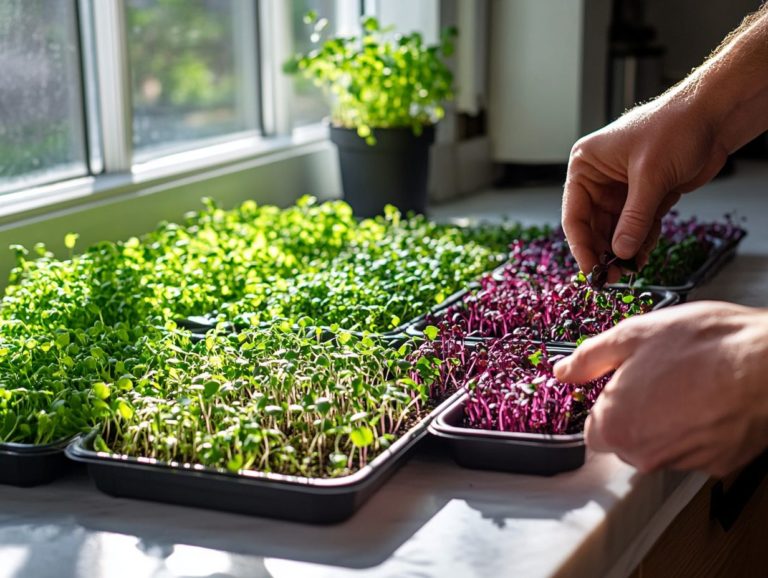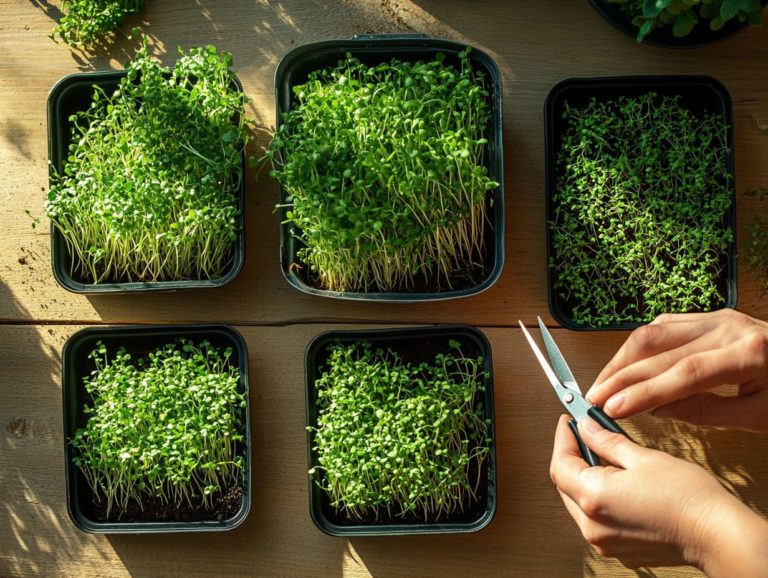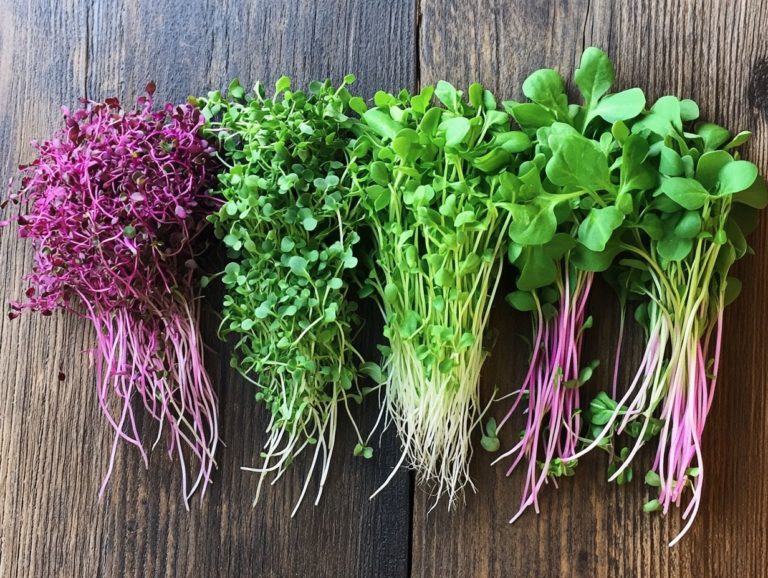Microgreen Varieties That Enhance Your Garden
Microgreens are tiny, edible plants. They are packed with flavor and nutrients, making them favorites among health-conscious eaters and cooks.
In this exploration, you will discover what microgreens are, the various types of microgreens, their unique characteristics, and how effortlessly you can cultivate them in your own garden with easy-to-grow microgreens kits.
This journey will unveil their remarkable health benefits and provide you with delightful ideas for weaving these vibrant greens into your meals.
Get ready to transform both your gardening and dining experiences!
Contents
Key Takeaways:
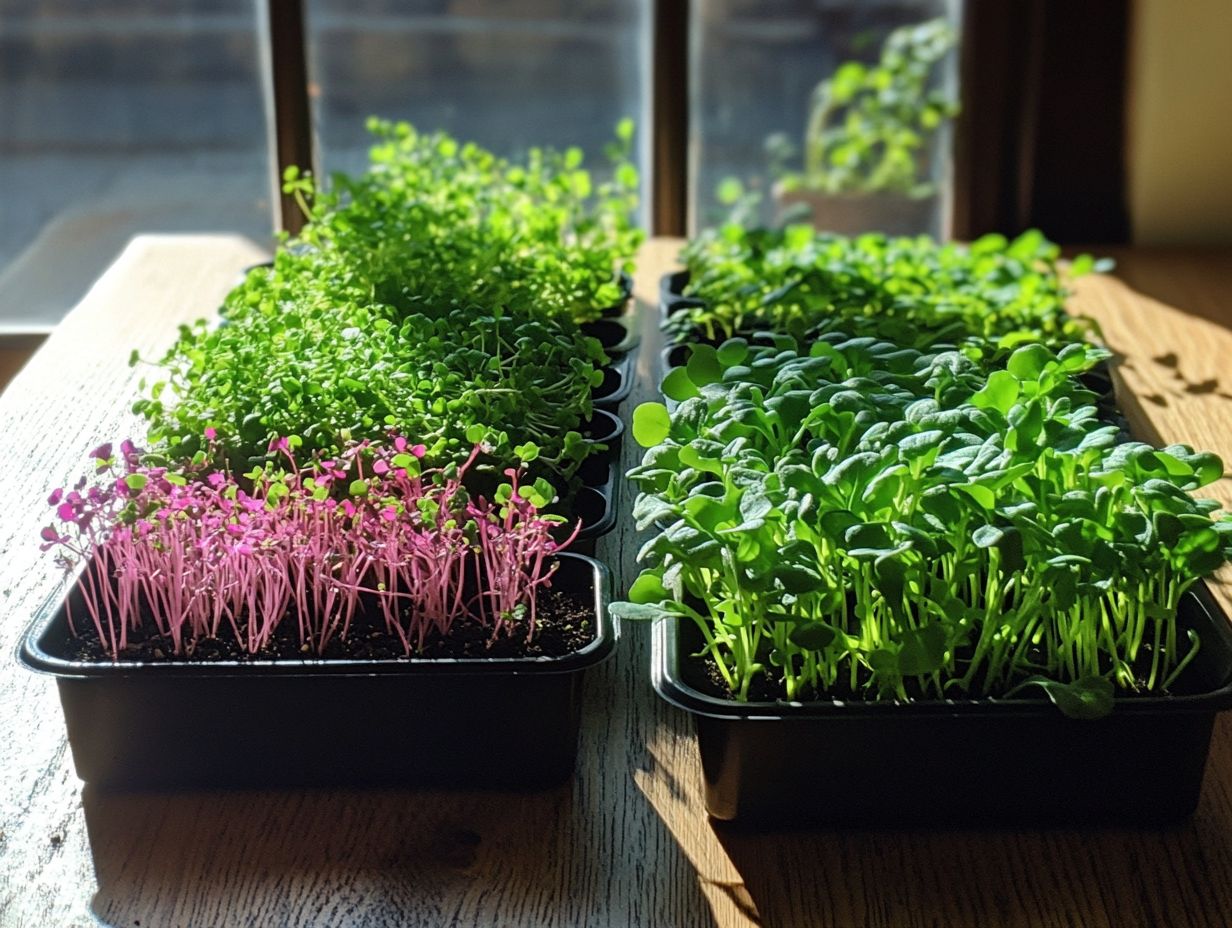
- Discover the benefits of incorporating microgreens into your garden, including their high nutritional value and potential health effects.
- Learn about common varieties of microgreens and their unique characteristics, such as flavor and appearance.
- Explore simple ways to incorporate microgreens into your diet with recipe ideas and tips for growing them in your own garden.
What are Microgreens?
Microgreens are young plants that are packed with nutrients. You can harvest them right after the first true leaves emerge. These petite greens deliver a burst of flavor and a host of health benefits, making them a favorite among health-conscious eaters and culinary enthusiasts.
With their bright colors and varied flavor profiles, microgreens can elevate any dish into a gourmet delight. They re not only simple to cultivate in home gardening setups, but they also flourish in indoor environments, providing a sustainable avenue for incorporating healthy foods into your diet.
Definition and Benefits
Microgreens are the young, edible plants you can harvest at their juvenile stage, celebrated for their remarkable nutritional value and health benefits.
These petite powerhouses, which include varieties like Kale, Broccoli, and Radish, are brimming with an impressive array of vitamins, minerals, and antioxidants, making them a formidable addition to your diet. For an exciting twist, consider exploring must-try microgreen varieties for salads. They deliver essential nutrients like vitamins C, E, and K, while providing a convenient way for you to enhance your overall health.
Cultivating microgreens is incredibly straightforward; they thrive in small spaces with little more than soil, water, and sunlight, making them accessible even for those just starting their gardening journey. Their vibrant flavors and textures can elevate your dishes, and the benefits of growing diverse microgreen varieties underscore their concentrated health benefits, proving that exceptional things often come in small packages.
Types of Microgreens
You will discover an astonishing variety of microgreens, each offering distinct flavors, culinary applications, and health benefits that elevate your dishes to new heights.
Common Varieties and Their Characteristics

Common microgreen varieties like Arugula, Cilantro, and Mustard each present their own distinctive flavor profiles and health benefits.
These young plants enhance the visual appeal of any dish with their vibrant colors and introduce unique flavors that can elevate even the simplest meals. Picture Arugula, with its peppery bite, adding a lively touch to your salads or serving as a delightful garnish on pasta. Cilantro, boasting fresh and citrusy notes, complements various cuisines, shining particularly in salsas and Asian dishes. Then there’s Mustard microgreens, offering a zesty crunch that perfectly pairs with sandwiches and wraps. For a comprehensive overview, check out the microgreen varieties: taste and flavor guide.
Beyond just flavor, these microgreens are brimming with vitamins, making them a nutritious choice. If you’re considering growing your own, ways to enhance flavor in microgreens include selecting the right varieties that thrive in well-drained soil and bask in ample sunlight, making them ideal for both indoor and outdoor gardening.
Growing Microgreens in Your Garden
Growing microgreens is not just a hobby; it’s an exciting and rewarding journey that gives you the power to cultivate your own nutrient-dense greens right in the comfort of your home, regardless of your gardening expertise.
Step-by-Step Guide to Growing Microgreens
To successfully grow microgreens, you ll want to follow a straightforward step-by-step guide that guarantees optimal growth and yield, especially if you’re just starting out on this gardening journey.
Your journey begins with the essential task of selecting the right seeds. Consider varieties like radish or sunflower, each offering unique flavors and nutrients.
Once you’ve made your selection, preparing an appropriate growing medium is vital. Ensure it provides good drainage and aeration for healthy plants. When you sow, remember to distribute the seeds evenly across the surface of the soil; this simple act fosters robust growth. For those interested in enhancing their culinary skills, exploring microgreen varieties for culinary professionals can be incredibly beneficial.
Regular, gentle watering is key to keeping the soil consistently moist—just avoid turning it into a swamp. Lighting is crucial. Place your trays under bright, indirect light for about 12-16 hours a day to set the stage for success. Additionally, incorporating unique microgreens to elevate your dishes can enhance your culinary experience. Watch the temperature, aiming for a cozy range of 60-75 F to promote rapid germination.
Finally, harvest at the perfect moment right when the cotyledons (the first leaves) begin to unfold to ensure you capture the full spectrum of flavor and nutrition.
Health Benefits of Microgreens
Microgreens are gaining recognition for their impressive health benefits and exceptional nutritional value. Often hailed as superfoods, they offer a concentrated dose of vitamins, minerals, and antioxidants that can elevate your diet and overall well-being.
Nutritional Value and Potential Health Effects
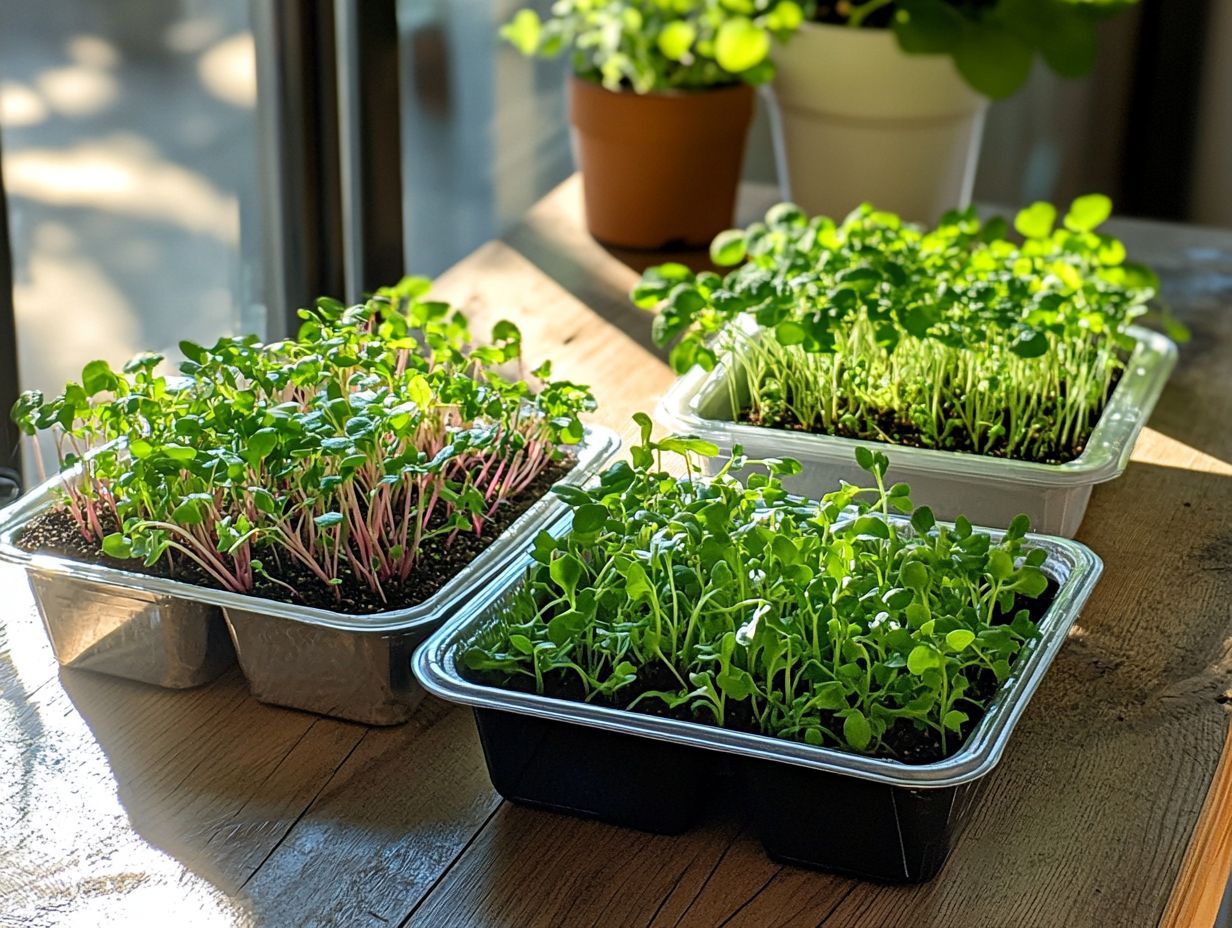
The nutritional value of microgreens is genuinely impressive, boasting a concentration of vitamins, minerals, and antioxidants that far surpasses that of their mature counterparts. This exceptional array of nutrients highlights a diverse selection of beneficial compounds that can significantly enhance your overall health.
Microgreens such as broccoli, kale, and radish are especially noteworthy, as they are brimming with essential vitamins like A, C, and E, key allies in boosting your immunity and promoting skin health. For those interested in expanding their knowledge, a quick guide to common microgreen varieties can be helpful. Their mineral content, including calcium and magnesium, provides vital support for bone density and muscle function.
Furthermore, the antioxidants found in microgreens, such as sulforaphane and quercetin, can be instrumental in combating oxidative stress. This, in turn, promotes better digestive health and helps reduce inflammation throughout the body. Incorporating these vibrant greens, including seasonal microgreen varieties for year-round growth, into your meals is a game changer, unlocking significant long-term health benefits that may enhance your well-being in ways you never imagined.
Ways to Incorporate Microgreens into Your Diet
Incorporating microgreens into your diet presents a delightful and nutritious opportunity to elevate your meals. These tiny powerhouses offer a diverse range of flavors and culinary applications that can enhance both the taste and nutritional profile of your dishes.
Recipe Ideas and Tips
Here are some enticing recipe ideas and tips for seamlessly incorporating microgreens into your daily meals, ensuring that healthy eating becomes a delightful and flavorful experience.
Microgreens are incredibly versatile ingredients that can elevate a wide range of dishes with their vibrant colors and distinct flavors. Imagine sprinkling some on your sandwich for that perfect crunch or tossing them into a salad to add a burst of freshness. These tiny greens not only enhance the visual appeal of your meals but also deliver a powerful nutritional boost.
Consider pairing spicy radish microgreens with creamy avocado for a delightful contrast, or let the mild flavor of pea shoots beautifully complement your hearty soups. By exploring microgreen varieties: a guide for beginners that showcase these unique greens, you can uncover the best ways to reap their benefits while transforming ordinary meals into culinary masterpieces.
Frequently Asked Questions
What are microgreens?
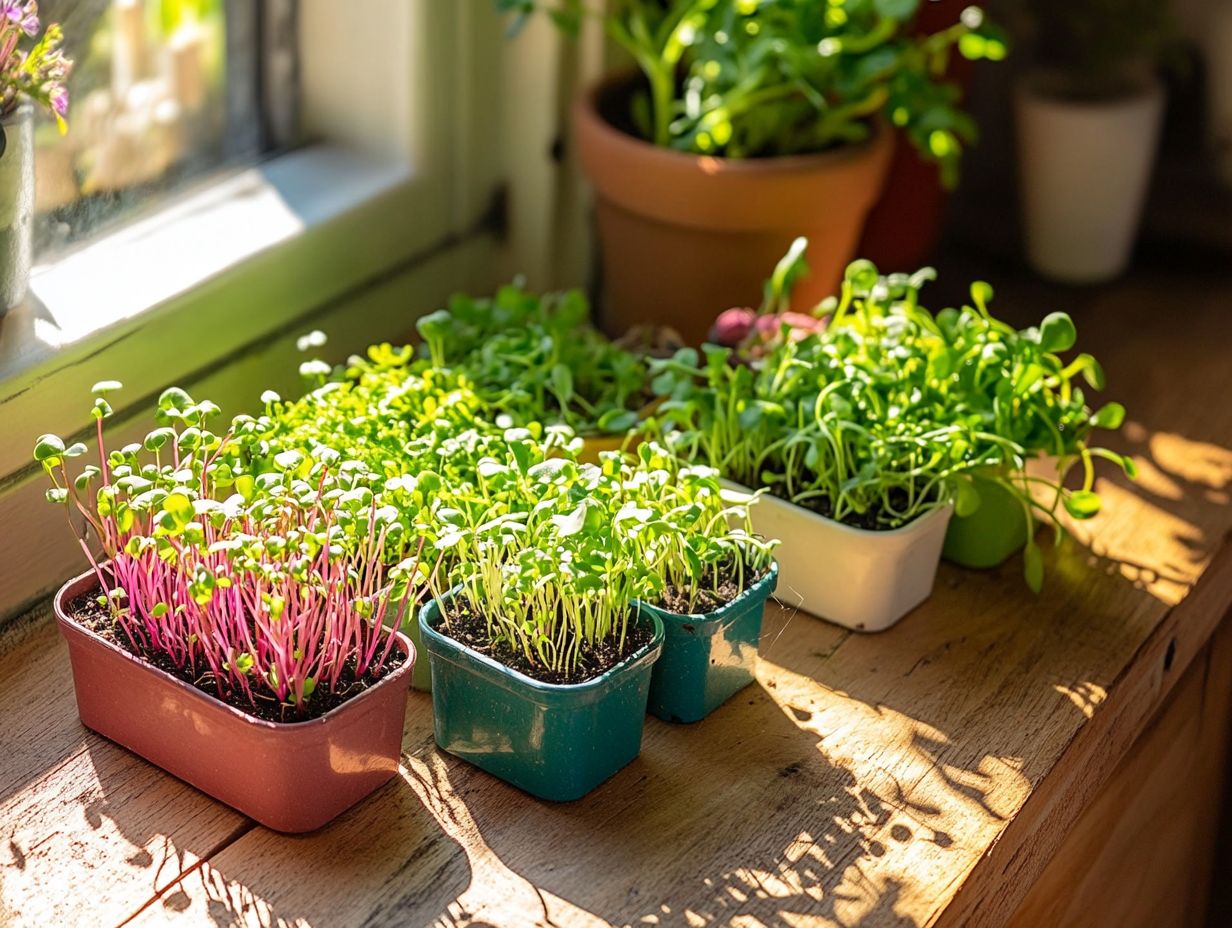
Microgreens are young edible plants harvested at the seedling stage, usually within 10-14 days after sprouting. They pack a punch of flavor and nutrition!
Start your microgreens journey today and experience the health benefits for yourself!
How do microgreen varieties enhance your garden?
Microgreens add visual appeal to your garden. They also provide an abundance of nutrients and flavor to your dishes.
What are some popular microgreen varieties?
Popular microgreens include broccoli, kale, radish, sunflower, and pea shoots.
Can I grow microgreens in my garden year-round?
Yes! Microgreens are versatile and can thrive in both indoor and outdoor gardens throughout the year.
Do microgreen varieties require a lot of space to grow?
No, microgreens can be grown in small containers. They are perfect for urban gardens and limited spaces.
How do I harvest microgreens?
Harvesting microgreens is simple! Snip the stems just above the soil level with clean scissors or kitchen shears.




